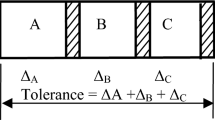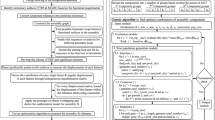Abstract
Quality of an assembly of any manufactured product is mainly based on the quality of mating components. Due to random variations in sources such as materials, machines, operators, and measurements, mating components manufactured by even the same process may vary in their dimensions. When mating components are assembled linearly, the resulting assembly tolerance will be the sum of the mating components tolerances. All precision assemblies demand for a closer assembly tolerance. A significant amount of research has already been done to minimize assembly variation using selective assembly, when the dimensions of components follow normal distribution. However, in reality, the dimensions of components produced especially in smaller to medium size batches, invariably have some skewness (non-normality), which makes the methods developed and reported in the literature, often not suitable for practice. In this work, batch selective assembly methodology is proposed for components having non-normal distributions to minimize the assembly tolerance variations. The proposed method which employs a genetic algorithm for obtaining the best combination of mating components is able to achieve minimum variations in assembly tolerances and also maximum number of acceptable assemblies. The proposed algorithm is tested with a set of experimental problem datasets and is found outperforming the other existing methods found in the literature, in producing solutions with minimum assembly variation.
Similar content being viewed by others
References
Mansoor EM (1961) Selective assembly—its analysis and applications. Int J Prod Res 1(1):13–24
Desmond DJ, Setty CA (1962) Simplification of selective assembly. Int J Prod Res 1(3):3–18
Ya RV, Mentov KV, Novikov VV (1979) Automatic sorting of rings by size prior to selective assembly. Meas Technol 22(1):71–73
Pugh AG (1986) Partitioning for selective assembly. Comput Ind Eng 11:175–179
Pugh AG (1992) Selective assembly with components of dissimilar variance. Comput Ind Eng 23:487–491
Fang XD, Zhang Y (1995) A new algorithm for minimizing the surplus parts in selective assembly. Comput Ind Eng 28:341–350
Chan KC, Linn RJ (1998) A grouping method for selective assembly of parts of dissimilar distributions. Qual Eng 11(2):221–234
Chen M-S (1996) Optimising tolerance allocation for mechanical components correlated by selective assembly. Int J Adv Manuf Technol 12:349–355
Kannan SM, Jayabalan V, Jeevanantham K (2003) Genetic algorithm for minimizing assembly variation in selective assembly. Int J Prod Res 41:3301–3313
Ponnambalam SG, Saravana Sankar S, Sriram S, Gurumarimuthu M (2006) Parallel populations genetic algorithm for minimizing assembly variation in selective assembly. Proceeding of the 2006 IEEE International Conference on Automation Science and Engineering, 496–500
Kannan SM, Sivasubramanian R, Jayabalan V (2008) Particle swarm optimization for minimizing assembly variation in selective assembly. Int J Adv Manuf Technol 42:793–803
Stoll HW (1999) Product design methods and practices. CRC Press, Boca Raton
Yan Wang Y (2008) Semantic tolerance modelling with generalized intervals. J Mech Des. doi:10.1115/1.2936900, Volume 130, issue 8, 7 pages
Fujino Y (1987) Matching problem when lot size is large. Rep Stat Application Res 34:1–10
Shan HS, Satyawadi A (1989) Computer-aided component selection for precision assembling. 10th international conference on production research. University of Nottingham, UK, pp 734–739
Coullard CR, Gamble AB, Jones PC (1998) Matching problems in selective assembly operations. Ann Oper Res 76:95–107
Akachai Jantayavichit (2000) Efficient algorithms for tolerance improvement through selective assembly. Ph.D. thesis, University of Wisconsin-Madison, pp. 128–160
Osma A (2009) A statistical approach to comparing whell hub forging processes. Proc Int Mech Eng Part D, Journal of Automobile Engineering 223:1559–1576
Lind DA, Marchal WG, Wathen SA (2005) Statistical techniques in business and economics, 12th edn. McGraw-Hill, New York
Author information
Authors and Affiliations
Corresponding author
Rights and permissions
About this article
Cite this article
Victor Raj, M., Saravana Sankar, S. & Ponnambalam, S.G. Optimization of assembly tolerance variation and manufacturing system efficiency by using genetic algorithm in batch selective assembly. Int J Adv Manuf Technol 55, 1193–1208 (2011). https://doi.org/10.1007/s00170-010-3124-2
Received:
Accepted:
Published:
Issue Date:
DOI: https://doi.org/10.1007/s00170-010-3124-2




